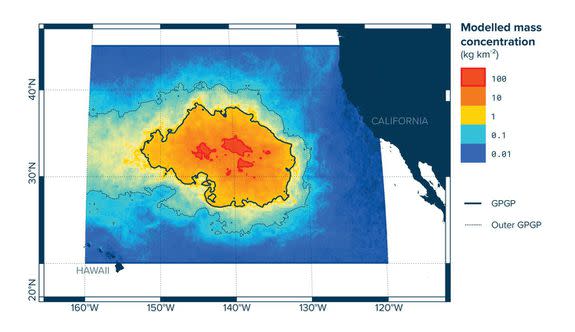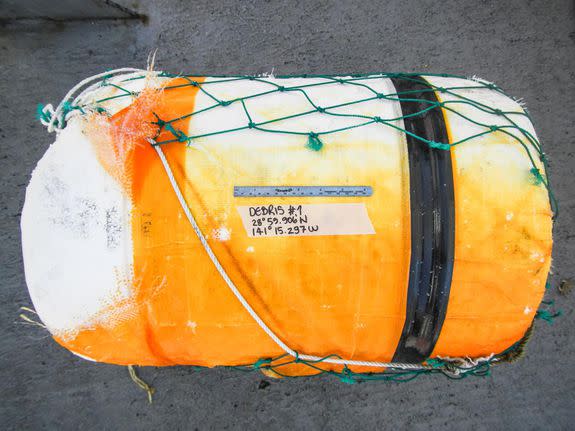The Great Pacific Garbage Patch is up to 16 times more massive than thought

The Great Pacific Garbage Patch (GPGP), a massive area of floating plastic debris that is more than twice the size of Texas, contains about 1.8 trillion pieces of plastic. This is between 4 and 16 times the mass of plastic that scientists previously estimated.
What's worse is that the amount of plastic within this area is growing "exponentially," according to a comprehensive three-year-long study using 30 vessels and a high-tech reconnaissance aircraft.
The study, published Thursday in the journal Scientific Reports, provides a detailed analysis of the size and types of plastic caught up in the Garbage Patch, which occupies about 1.6 million square kilometers, or 617,763 square miles, between Hawaii and California.
SEE ALSO: A floating 'island of trash' has surfaced in the Caribbean
The GPGP is just one of five ocean garbage patches that have developed around the world as people use more and more plastic, which is not biodegradable and is used for everything from water bottles to shipping crates.
A fleet of 30 vessels, each dragging nets behind them to scoop up pieces of plastic, gathered 1.2 million samples. Scientists from The Ocean Cleanup Foundation in the Netherlands, as well as six universities and an aviation sensor company, used the samples they'd gathered to build a model of how plastic is transported in and out of the GPGP.
The study estimates that the approximately1.8 trillion pieces of plastic within the GPGP weighs about 80,000 metric tons. Another unexpected finding: Most of this mass — 92 percent — is composed of large plastic debris, such as crates and bottles, while just 8 percent or so of the mass is made up of microplastics, pieces smaller than 5 millimeters in size.

Image: THE OCEAN CLEANUP FOUNDATION/lebreton et. al. scientific reports.
"We were surprised by the amount of large plastic objects we encountered," said Julia Reisser, chief scientist of the expeditions, who works for The Ocean Cleanup Foundation, in a press release.
At least 46 percent of the mass was composed of ghostnets, or fishing nets drifting at sea, unmoored from the ships that once towed them, the study found.
“There’s a lot more plastic out there than thought,” said Boyan Slat, a co-author of the study and founder of The Ocean Cleanup Foundation, in an interview.
Unlike earlier studies, which focused on collecting small pieces of plastic within a smaller area of the GPGP, this one attempted to capture the full range of debris floating in the GPGP. The armada of research ships used small nets to catch the small pieces, large ones to wrangle the medium-to-large pieces, and a C-130 Hercules aircraft equipped with LIDAR equipment in order to detect "these mega-pieces” of larger than 1 meter, Slat said.
Using their transport model, the researchers pointed to Asia as a main source of plastic pollution for the GPGP, particularly Japan and China, though plastics from North America contribute to it as well. Plastics that get routed into the Garbage Patch by winds and ocean currents are likely to be permanently trapped there, in a zone of little wind and devoid of weather systems that would break up and disperse the debris. Eventually, some of the surface plastic does sink to the ocean bottom, where it can endanger marine life.

Image: the ocean Cleanup Foundation.
The researchers used an "apples to apples" comparison of small plastic pieces, dating back to 1970, to analyze their mass estimates against previous studies, Slat said. The conclusion was inescapable: There is more and more plastic being added to the Garbage Patch each year, with far less plastic escaping, to the point where it's undergoing exponential growth.
This May, scientists and engineers affiliated with The Ocean Project plan to test out technology to clean up plastic from the sea, using a vessel off the California coast. The eventual plan is for the group to reduce plastic pollution by cleaning up the GPGP and similar areas of plastics around the world.
The nearly $40 million initiative relies on private funding; since 2013, they'd been raising funds using crowdfunding. Now, according to Slat, the group relies on a group of anonymous philanthropists, split about equally between Silicon Valley and Europe. One prominent investor is Marc Benioff, the founder and CEO of Salesforce, Slat said.
“We need to understand how much plastic is out there so that we can clean it up,” Slat said.
The goal is to have the first plastic from the Garbage Patch recovered and back in port before the end of this year, Slat said. On its website, the foundation says its goal is to clean up 50 percent of the GPGP recovered within five years of deployment.
